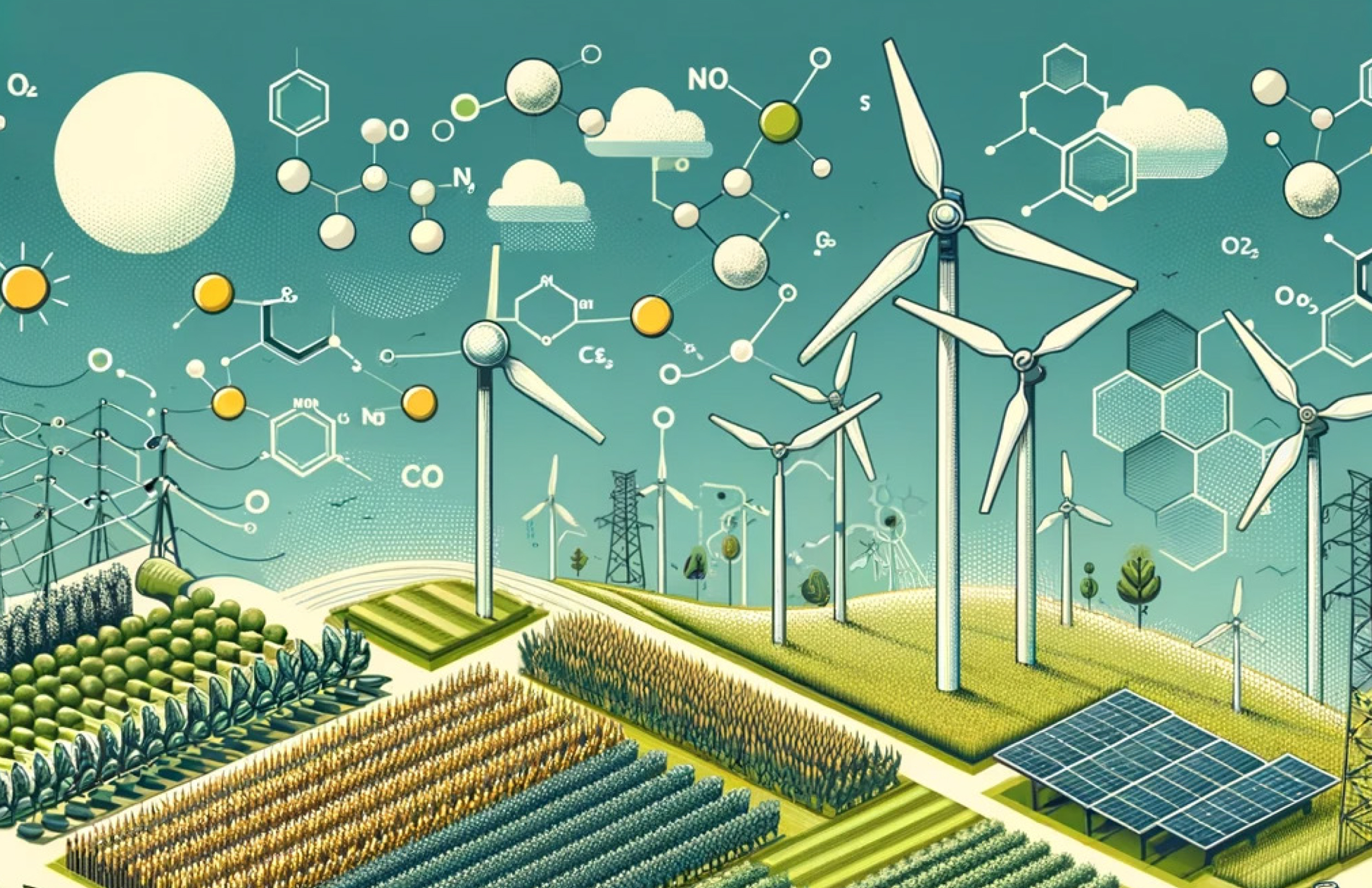Taking a bite out of carbon emissions
Follow CDE
PDF Download

As climate change influences weather patterns and upsets food systems, researchers think it’s time to reimagine how food is farmed to ensure its security and sustainability.
Agriculture, for millennia, has been the backbone of societies, from Neolithic homo sapiens who favoured a reliable food supply over traditional hunter-gatherer lifestyles, to the Chinese Han Dynasty that birthed many agricultural inventions to improve farming efficiencies.
As societies all over the globe sowed the seeds of agriculture, cities and civilisations flourished, crops and livestock could be farmed to meet — and exceed — demand, and as a result, the global population skyrocketed, from some 5–6 million people 12,000 years ago to over eight billion today.
With such a boom in population comes unprecedented challenges, one of which is climate change. Today’s food systems collectively emit around one-third of global greenhouse gas emissions and guzzle 15% of fossil fuels. From production to distribution to the consumer’s fork, each phase of the modern food system contributes to these emissions. Significant waste is also generated throughout the value chain, with an estimated 30% of food produced for human consumption being discarded — amounting to about USD1 trillion lost annually.
Climate change and our food system are tightly interwoven. More frequent and severe weather events can fuel the destruction of harvests and threaten food security across the globe, perpetuating a vicious cycle that not only exacerbates climate threats but also disrupts food production and distribution, particularly impacting vulnerable populations. Land scarcity and the excessive use of pesticides and fertilisers also add to the issue.
Professor Yan Ning from the College of Design and Engineering at the National University of Singapore has an important part to play in contributing a solution to these global challenges. At the Department of Chemical and Biomolecular Engineering, Prof Yan leads a team to research and develop a sustainable approach to food production, called “green chemical farming”.
Instead of relying on nature-based biological routes — with sunlight and chlorophyll playing lead roles — green chemical farming turns the spotlight to a chemical sleight of hand and some clever engineering. The research team published their idea in Nature Sustainability on 23 June 2022.
Artificial interventions
With chemistry and chemical engineering as the two main pillars, green chemical farming replaces plant-based biomass with chemically produced functional molecules, subsequently transforming these compounds into usable, nutritious food components.
This alternative route reduces the reliance on increasingly scarce natural resources like land and water. Highlighting this urgency, The Guardian reported that the demand for fresh water is expected to exceed supply by 40% by the end of this decade.
Take some key compounds, such as water, carbon dioxide and ammonia, for example. In the team’s approach, these functional molecules can be transformed, ideally with the help of renewables, into hydrogen, a range of organics, and ammonia and amino acids, respectively.
“These chemical feedstocks can then be used as building blocks by a range of microbes, such as edible microalgae and yeast, for more complex food ingredients and flavouring,” explains Prof Yan. “The nutrient-laden microorganisms are subsequently harvested and processed as agricultural products and can be integrated with the rest of our food processing flow.”
The nutrients can also be upstream substrates for other emerging food technologies, including three-dimensional printing and non-animal-derived, laboratory-grown meat. The researchers looked into how green chemical farming might deliver new pathways to meat analogues that can complement traditional protein sources like beef.
Lab-grown cultured meat, which replicates animal muscle tissue, matching its protein profile and even taste, offers a sustainable alternative without emitting potent, planet-cooking greenhouse gases such as methane. This approach could create a significant dent in carbon emissions. To give a sense of the scale, cattle and dairy cows emit enough greenhouse gases to put them on par with the highest-emitting nations.
Putting the green gears in motion
While not yet demonstrated at a systemic level, the science underpinning green chemical farming is now being rigorously researched — with some technologies reaching maturity and developers scaling up their applications.
One of the key components is the development of materials for carbon dioxide adsorption, which has made carbon capture in power plants economically viable. This advancement has made the compound available as a feedstock at a cost-effective rate.
Complementing this are efforts to slash the costs of clean hydrogen, such as the US Department of Energy’s Hydrogen Shot initiative. This is vital for green chemical farming, as affordable hydrogen is essential for converting carbon dioxide and nitrogen into green chemicals.
Moreover, the development of corrosion-resistant multilayer anodes for seawater electrolysis is opening new routes for hydrogen fuel generation, further supporting the infrastructure needed for this innovative farming approach.
On the other hand, the production of amino acids from renewable carbon sources has recently been established, offering a sustainable pathway for single-cell protein production. These proteins are crucial for feeding microorganisms used in green chemical farming, such as model bacterial species and microalgae.
“Momentum is building, and a broad spectrum of research and incentives are making green chemical farming more palatable,” adds Prof Yan. “McKinsey reported that an annual investment of around USD840 billion in food and agriculture is necessary to reach net zero by 2050. This could stimulate demand for the supplies and equipment that enable decarbonisation, spurring the commercialisation of new technologies for alternative protein sources.”
A way to go to palatability
As with any transformative technology, the path to realising green chemical farming is strewn with significant technical and economic hurdles. While the underlying science shows promise, scaling it up to a level that can meaningfully contribute to global food supplies presents thorny challenges. The costs associated with developing and maintaining the required infrastructure, along with manoeuvring the complex chemical processes at scale, put economic viability to the stand.
Moreover, the integration of these new methods with existing agricultural systems requires extensive planning as well as a huge appetite for investment, potentially making it a less accessible option for developing regions.
Understandably, many consumers have yet to develop the taste buds for chemically or laboratory-grown proteins. The concept of consuming food that isn’t derived from traditional farming but instead created in laboratories or through chemical processes is, after all, a substantial departure from conventional dietary habits. Meanwhile, promoting such foods requires a delicate balance between evidence-based education and gradual introduction, as overly aggressive advocacy might backfire, inadvertently giving rise to public resistance and widening the gap of mistrust.
Food for thought
Green chemical farming is particularly attractive in regions where resources are scarce, land is finite and traditional infrastructure is inadequate.
“Singapore is a prime example, with a population of nearly six million squeezed into a space of 730 km2,” says Prof Yan. “The city-state is heavily reliant on imports for 90% of its food, making it especially prone to supply-chain snags— made prominent during the COVID-19 pandemic.”
Advancing green chemical farming entails multi-disciplinary R&D efforts. To overcome the associated challenges, Prof Yan has a few suggestions.
First, the feasibility of the approach must be validated through systems-level demonstrations. This involves chemists and chemical engineers working together to refine catalytic systems, enhancing the efficiency of key chemical reactions, while biochemists and bioengineers focus on identifying and addressing the rate-limiting steps in the production of biomass from non-conventional chemical substrates, such as ethanol.
In addition, cradle-to-grave and techno-economic analyses are essential to paint a clearer picture of the system’s carbon footprint, its comparative advantages and weaknesses, as well as areas requiring further improvement.
Equally crucial are rigorous studies ensuring food safety in the downstream processing of microbes into consumable products. In this context, consumer perception is key for the social acceptance of products derived from green chemical farming. The researchers underlined the importance of collaboration among governmental regulators, academic institutions, and the food industry to guarantee that these products can safely transition from farm to fork.
The traditional food-production industry should also be part of the equation. To grasp the broader impact of green chemical farming on the business landscape, environmentally extended input-outlet analyses are critical. These studies will reveal how this new approach affects various economic sectors, including standard food production, offering a window into its potential economic implications.
As the public and private sectors recalibrate the standard approach to food production in response to climate change, technologies like green chemical farming could become an integral element in a comprehensive strategy to mitigate its impacts on agriculture.
Driving that innovative spirit is the reality that even a slight increase in global temperatures can lead to profound, potentially irreversible disruptions in agricultural practices. This reality will, above all, inevitably impel a transformation of the sector in ways that are yet to be fully anticipated.
Related
Yan Ning ▏Professor, Department of Chemical and Biomolecular Engineering ▏LinkedIn Profile
Related Departments
Read More
View Our Publications ▏Back to Forging New Frontiers - April 2024 Issue
If you are interested to connect with us, email us at cdenews@nus.edu.sg








